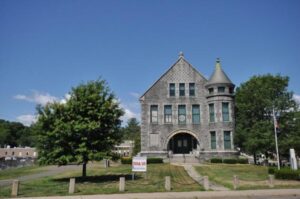by Philip R. Devlin
Memorial Hall is an historic meeting hall at South Main and Elm Streets in Windsor Locks, Connecticut. Finished in 1890 as a memorial to the town’s American Civil War soldiers, it has served for most of its existence has a meeting place for veterans’ organizations, from the Grand Army of the Republic to the American Legion. It is also one of the town’s finest examples of Romanesque architecture, and was listed on the National Register of Historic Places in 1987.
The hall was built in 1888 to a design by Frederick Savage Newman of Springfield, Massachusetts. The building was donated by Charles Chaffee, a mill owner from Monson, Massachusetts whose reason for the donation is not known. The building was constructed out of stone quarried in Monson as a memorial to Windsor Locks’ Civil War soldiers, and was intended for use by the Grand Army of the Republic and affiliated organizations. It is a beautiful building. Chaffee spent $30,000 on its construction.
The hall was dedicated to the memory of Major Joseph Hyde Converse of Windsor Locks, who was killed in action at the Battle of Cold Harbor on June 4, 1864, at the age of 26. His brother, Alfred Woods Converse, was also a veteran of the Civil War and survived him. The GAR was very active at the hall for many years; in fact, many of the local Civil War veterans donated their Civil War items used in battle to Memorial Hall for display. Among those donated items were nine rifles made at the Springfield Armory in Massachusetts, all with bayonets.
Windsor Locks Civil War veterans served in 16 different Connecticut army regiments during the war. One of these soldiers, Pvt. Frank Ferguson, served as an ambulance driver at General McClellan’s headquarters. His gun is marked as such with white paint on the stock.
Judge Arthur F. Eggleston, who served during the Civil War in the 46th Massachusetts Regiment, had this to say about the war veterans from Windsor Locks during his dedication address of Memorial Hall on June 10, 1891:
In the forefront of patriotic effort for the Union and civil liberty, were the men and women of Windsor Locks. One hundred and eighty-eight men of this village entered the Union Army, and, from the first battle of Bull Run to the final gun at Appomattox, soldiers from Windsor Locks were engaged in the battles of the republic. They were at Antietam, Gettysburg, and Cold Harbor, at Irish Bend, in the charges of Port Hudson and Fort Wagner, with Sheridan at the battle-scourged valley of the Shenandoah, with Sherman “from the mountains to the sea,” with Grant from the Potomac to the James, carrying forward the dear old flag to victory and peace.
Seventeen men from Windsor Locks died during the war and dozens of others were disabled. The town had barely 2,000 residents in 1860, so it paid a heavy price for its small size to save the Union. Today, the Windsor Locks Veterans group, led by World War II veteran Ed Sabotka, continues a long, local and honorable tradition to honor the sacrifice of town’s veterans at Memorial Hall.





